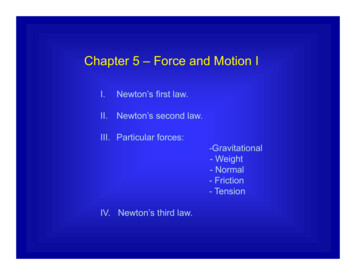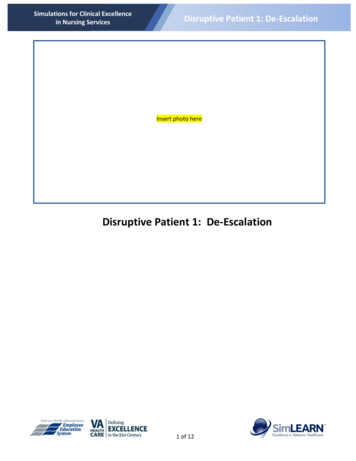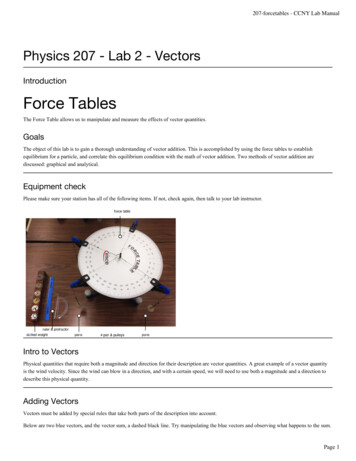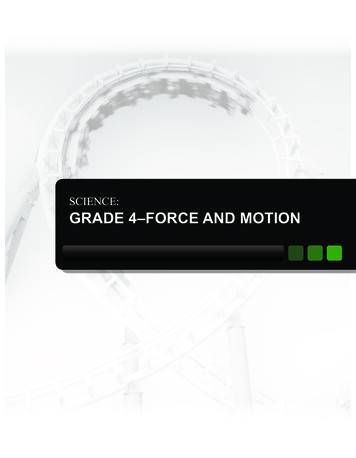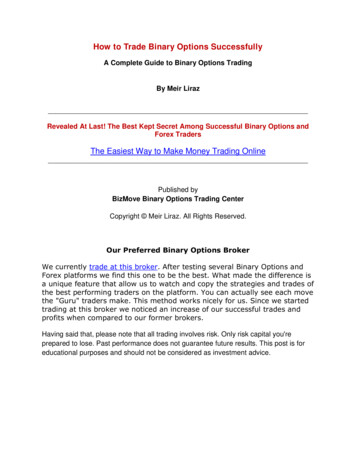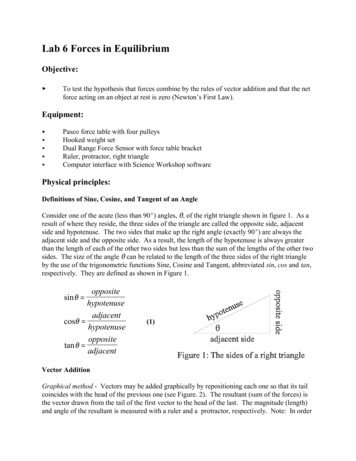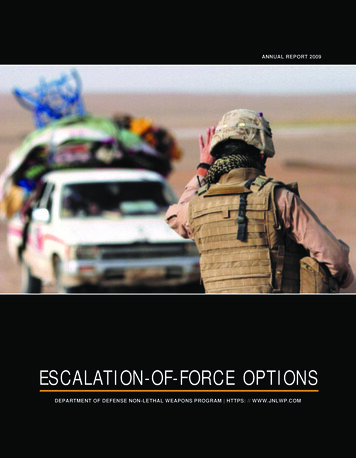
Transcription
ANNUALANNUAL REPORTREPORT 20092009ESCALATION-OF-FORCE OPTIONSDEPARTMENT OF DEFENSE NON-LETHAL WEAPONS PROGRAM HTTPS: // WWW.JNLWP.COMAnnual Report 2009 1
DoD Non-LethalWeapons ProgramExecutive Agent, DoD Non-Lethal Weapons ProgramGen. James T. Conway,Commandant of the Marine CorpsChairman, Joint Integrated Product TeamLt. Gen. Thomas D. WaldhauserDirector, Joint Non-Lethal Weapons DirectorateCol. Tracy J. TafollaDeputy Director, JNLWDDouglas J. Jerothe: douglas.jerothe@usmc.milPrincipal Deputy, Policy & StrategySusan D. LeVine: susan.levine@usmc.milStrategic Communication OfficerKelley S. Hughes: kelley.hughes@usmc.milBusiness Financial Management OfficerLinda B. Palmer: linda.palmer@usmc.milCapabilities & Requirements Division ChiefLt. Col. Paul L. Scholl: paul.scholl@usmc.milAcquisition Division ChiefKevin J. Swenson: kevin.swenson@usmc.milTechnology Division ChiefDavid B. Law: david.b.law1@usmc.milOperations Division ChiefMary A. Moody: mary.a.moody@usmc.milScience & Technology Program ManagerJohn P. Keenan: john.keenan2@usmc.milHealth Effects OfficerLt. Col. Anne H. Barrett, USAF: anne.barrett@usmc.milDoD NLW Annual Report Editorial BoardExecutive EditorsDouglas J. JerotheSusan D. LeVineKelley S. HughesPublication ManagementBethel “Buck” Q. EvansDavid W. HuntBarclay L. LewisProduction Lead & Coordinator/Staff WriterSuzette M. WesthoffAssociate EditorsIrina C. ClementsM. Annette BeachamLayout & Design TeamJennie M. ThomasWanda J. NapierJennifer A. BowenJoint Non-Lethal Weapons Directorate3097 Range Road Quantico, VA 22134(703) 784-1977 DSN: 278-1977https://www.jnlwp.comAll rights reserved. Articles, photographs and other material from the 2009Annual Report may be reproduced if they are not restricted by law or militaryregulations, provided proper credit is given and specific prior permission hasbeen granted for each item to be produced. Articles without bylines and photographs/graphics illustrations that do contain photo credit are to be credited tothe Department of Defense.1 Annual Report 2009USMC photo by Cpl Erin A. Kirk-Cuomo“Warfighters must have the capabilityto respond using both lethal and nonlethal force Non-lethal weaponapplications will provide new options forengaging personnel .”--General James T. ConwayCommandant of the Marine CorpsExecutive Agent, DoD Non-Lethal Weapons Program
Non-Lethal WeaponsNecessary and Relevant CapabilitiesAmerica’s forces have been heavily committed tocontingency operations at home and abroad during2009. Success in these operations demands that ourmilitary and our allies avoid innocent civilian casualtiesand unnecessary collateral damage while engaging anenemy who has chosen to intermingle with noncombatants.Non-Lethal Weapons provide a necessary and relevantcapability, applicable across a range of militaryoperations, to complement lethal weapons and supportescalation-of-force situations in today’s operations. Theprominence of non-lethal weapons in both United Statesand Allied operations continued to increase in 2009. Inaddition to a growing number of Joint and Service urgentneed requests for non-lethal weapons, deploying units arenow required to train with non-lethal weapons prior todeployment to overseas contingency operations.Combatant Commanders and Commanders at all levelshave a clear understanding of the significant strategic,operational and tactical impact and value of non-lethalforce application.As you will see in this year’s Annual Report, theDepartment of Defense Non-Lethal Weapons Program iscommitted to the development and fielding of precise,effective, longer range and lighter weight non-lethalweapons to meet warfighter requirements. This reportcaptures highlights of program activities and actionsunderway in the development of directed energy, andkinetic weapons andmunitions. The effortsdescribed in human effectsresearch, acquisition,requirements generation,science, technology, and nonlethal weapons training andeducation during the year willlay the foundation forachieving the improvementsrequired to support our forces.Lt. Gen. Thomas D. Waldhauser(Official USMC Photo)Our Joint Force continues to be called upon to win ournation's wars and address a range of national securitychallenges. The Department of Defense Non-LethalWeapons Program is committed to delivering flexible andeffective non-lethal capabilities to help meet thosechallenges.Lt. Gen. Thomas D. WaldhauserUnited States Marine CorpsChairman, Joint Non-Lethal WeaponsIntegrated Product TeamOperational Relevance . 4Near-Term Capabilities . 17DoD Non-Lethal Weapons Program . 8Emerging Capabilities . 19Combatant Command Mission Requirements . 9Enhancing NLW Knowledge . 22Initial Capability Documents . 10Global Reach . 23Human Effects . 11U.S. Partnerships . 25Current Capabilities . 14Director’s Comments . 26Annual Report 2009 2
Warfighters need non-lethalweapons, which will provideescalation-of-force options,minimizing civilian casualtiesand collateral damage.iStockphoto3 Annual Report 2009
Non-Lethal WeaponsOperational RelevanceDepartment of Defense Directive 3000.3, Policy for Non-Lethal Weapons,defines non-lethal weapons as “Weapons that are explicitly designed andprimarily employed so as to incapacitate personnel or material, whileminimizing fatalities, permanent injury to personnel, and undesired damage toproperty and the environment. Unlike conventional lethal weapons that destroytheir targets through blast, penetration, and fragmentation, non-lethal weaponsemploy means other than gross physical destruction to prevent the target fromfunctioning.”Non-lethal capabilities provide escalation-of-forceoptions for United States military forces. Today’sincreasingly complex operational environments requireescalation-of-force capabilities that complement lethalweapons. They provide personnel with force applicationand force protection capabilities for use when lethal forceis an undesirable first option.Non-lethal weapons, devices and munitions enablemilitary forces to avoid unnecessary casualties and minimize collateral damage to infrastructure. Although operational situations do not always progress from non-lethal tolethal force, non-lethal capabilities facilitate our ability tolimit or control the escalation of violence when the use oflethal force could be either tactically or strategically counterproductive. This Annual Report will highlight theDepartment of Defense Non-Lethal Weapons Program’s2009 accomplishments and efforts, and outlines futurenon-lethal capabilities.Combatant Commanders recognize the role that nonlethal weapons play in Cooperative Security, IrregularWarfare and Stability Operations. United States’ forcesare currently using non-lethal weapons for crowd control,detainee operations, checkpoint operations, convoy opera-tions and area denial. For example, optical devices such asdazzling lasers have proven effective in safely providingwarning to personnel approaching checkpoints and havereduced the number of civilian casualties at securitycheckpoints in the Central Command Area of Operations.The following notional scenarios represent typicaloperations in which non-lethal weapons are used to effectively determine intent and respond with appropriatelevels of force.These scenarios illustrate the complex environment ourmilitary forces may face in current operations in remotecommunities, foreign ports and crowded urban centerswhere combatants may intentionally intermingle withcivilians. Our Soldiers, Sailors, Airmen, Marines andCoast Guardsmen must quickly choose whether to uselethal force in uncertain situations with limited time anddistance to determine the intent of individuals or groups.In many cases, the use of non-lethal weapons may provideour forces information to help them make critical choicesor to resolve situations without resorting to lethal force.Non-lethal weapons provide them a better opportunity toachieve the mission without unnecessary fatalities, permanent injuries or damage to property.Annual Report 2009 4
Scenario 1:Convoy OperationsScenario 1:Convoy OperationsAsmall military unit providing convoy escortand route security for a humanitarian reliefsupply mission spots a crowd of individuals blockingthe road. The unit leader orders the convoy to slowdown. He is aware of enemy tactics that mix combatants with non-combatants, which make it difficult todistinguish friend from foe. Based on a quick assessment, the unit leader determines that the crowd possibly includes a mixture of antagonistic demonstratorsand onlookers. The unit leader uses an acoustic hailing device equipped with a translation apparatus to5 Annual Report 2009issue a warning to clear the road. However, thecrowd shows no sign of dispersing. Some of thedemonstrators in the crowd begin throwing rocks.Although he is eager to resume the convoy’s operation, the unit leader is also keenly aware of the needto de-escalate the situation without harming innocentbystanders. Unit members fire non-lethal sting-ballgrenades, which cause the crowd to disperse whileavoiding civilian injuries and property damage. Theconvoy resumes and successfully delivers itshumanitarian relief supplies.
Scenario 2:Maritime SecurityAsurface combatant ship approaches a harbor entry channel for a port call. The crew observes a rusted fishing vesselapproaching 1,000 meters off the ship’s starboard side. The suspicious vessel continues its approach. The captainorders the bridge watch to employ an acoustic hailing device. The device’s loud warning tones and voice commandscause the suspect vessel to slow its approach. The ship’s security detachment then fires Non-Lethal Warning Munitions todeliver a warning using light, sound and smoke to deter the suspect vessel from coming closer. The combination of thewarning munitions and the acoustic hailing device’s intolerable sound compels the suspect vessel to change course.Acoustic Hailing DeviceAnnual Report 2009 6
Scenario 3:Perimeter ControlGlare MOUT EffectAn infantry squad has set up aperimeter to protect militaryconstruction personnel rebuilding avillage school. A small truckapproaches the construction site. Asthe vehicle approaches the entry control point of the construction site, thedriver fails to obey the posted signs7 Annual Report 2009Glare MOUTinstructing drivers to stop. Squadmembers suspect that the driver maynot be complying because he is inattentive or does not understand theposted signs. They focus an eye-safe,non-lethal, green laser at the vehicle’s windshield to optically distractand warn the driver to stop. How-ever, the vehicle continues toadvance until it encounters a preemplaced, reusable vehicle stoppingnet, called a Portable Vehicle Arresting Barrier. The Portable VehicleArresting Barrier successfully stopsthe vehicle.
Department of DefenseNon-Lethal Weapons ProgramIn response to requests from Commanders in the field, in1996 the Deputy Secretary of Defense released amemorandum implementing a Non-Lethal WeaponsProgram, and published Department of Defense Directive3000.3. The Directive defined non-lethal weapons,established policy for use of non-lethal weapons andassigned the Commandant of the Marine Corps as theExecutive Agent for the Department of Defense NonLethal Weapons Program. The Directive also assignedprogram oversight to the Under Secretary of Defense forAcquisition, Technology and Logistics and policy oversight to the Assistant Secretary of Defense for SpecialOperations/Low-Intensity Conflict.The Department of Defense Non-Lethal WeaponsProgram stimulates and coordinates the non-lethalweapons requirements of the Armed Services and allocatesresources to help meet them. The Services coordinate andwork with the Combatant Commands and the ExecutiveAgent through an established joint process to identifyrequirements and then plan, program and fund non-lethalweapons research, development and acquisition. Alsowithin the larger Department of Defense Program, theJoint Non-Lethal Weapons Program supports thedevelopment of integrated and fully supported systemsdesigned to give Commanders non-lethal escalation-offorce options. The Joint Non-Lethal Weapons Directorate,acting on behalf of the Executive Agent, serves as theDepartment’s focal point for matters regarding non-lethalweapons.The fiscal year 2009 Department of Defense NonLethal Weapons Program budget consisted ofapproximately 130 million of Joint Non-Lethal WeaponsProgram and Service funding. The 64 million in JointNon-Lethal Weapons Program funding supported Jointresearch, development, testing and evaluation, and scienceand technology endeavors. Service funding was used todevelop, purchase, operate and maintain current non-lethalweapons.The DoD Non-LethalWeapons Programstimulates andcoordinates the nonlethal weaponsrequirements of theArmed Services andallocates resources tohelp meet them.Direct OversightCoordinationAnnual Report 2009 8
United States Soldiers from Alpha Company, 1st Battalion, 17th Infantry Regiment, 5th Brigade Combat Team, 2nd InfantryDivision meet with a village elder in Dilak-e Pa'in, Afghanistan. (Official USAF Photo)Combatant CommandMission RequirementsThe Department of Defense Non-Lethal WeaponsProgram’s efforts are driven by the requirements ofUnited States operating forces. Today’s increasinglycomplex and fluid military operations require a range ofcapabilities that give our forces the ability to minimizeunintended casualties and collateral damage whenappropriate. Non-lethal weapons provide such capabilities,offering our forces a complement to lethal weaponsappropriate for a wide range of military operations;including irregular warfare, stability and supportoperations, and support to civil authorities. Consequently,non-lethal weapons will continue to provide escalation-offorce options within the range of military operations.9 Annual Report 2009Combatant Commands recognize the military utility ofnon-lethal weapons and are incorporating them into theiroperational planning and guidance. Three of the Combatant Commands (United States Central Command, UnitedStates European Command and United States Joint ForcesCommand) have incorporated non-lethal weapons intotheir Integrated Priority Lists, with European Commandmentioning non-lethal weapons as an enduring issue.Explicit or implied requirements for non-lethal capabilities rank high on Integrated Priority Lists.Non-lethal weapons, as a complement to lethal weapons, provide the means to control escalation of hostilitiesin many situations and can help our forces maintain the“moral high ground,” while enhancing population securityand retaining force protection capabilities.
Initial Capability Documents“ . It doesn't even matter if the enemy hides behindcivilians. What matters are the death and destructionthat result and the expectation that we could haveavoided it. In the end, all that matters is that, despite ourbest efforts, sometimes we take the very lives we aretrying to protect You cannot defeat an insurgencythis way.”--Adm. Michael MullenChairman, Joint Chiefs of StaffThe Services develop non-lethalcapabilities by reviewingwarfighter requirements, assessingthe requirements to determine andprioritize capability gaps andidentifying non-lethal solutions tomitigate those gaps. The Departmentof Defense’s non-lethal weaponscapabilities are identified accordingto Chairman of the Joint Chiefs ofStaff Instruction (CJCSI) 3170.01G,Joint Capabilities Integration andDevelopment System. By analyzingscenarios and specific missions, allnecessary capabilities are rigorouslyreviewed. When current resourcescannot meet a requirement, the JointCapabilities Integration andDevelopment System processidentifies, assesses and prioritizesmateriel and non-materiel approachesto provide required capabilities.lethal weapons development andfielding. They will guide conceptrefinement and technology development of non-lethal capabilities andmay be the source of one or moreCapability Development Documents.The approved Initial CapabilitiesDocuments also help focus researchinvestments toward resolving nonlethal weapons capability gaps.Additionally in 2009, work beganon updating the Department ofDefense Non-Lethal CapabilitiesRoadmap. The updated Roadmapwill integrate the results of the JointNon-Lethal Effects CapabilitiesBased Assessment, which was completed in 2008, allowing mapping ofcurrent and future non-lethalweapons to capability gaps. TheRoadmap will serve as a frameworkfor facilitating decision-making andmanagement of the Department’sintegrated non-lethal weaponscapabilities portfolio.Capabilities-Based AssessmentIdentified Required CapabilitiesIdentified and Prioritized Capability GapsRecommended Materiel and/orNon-Materiel SolutionsInitial Capabilities DocumentsIn April 2009, the JointCapabilities Board approved theInitial Capabilities Documents forCounter-Personnel and CounterMateriel Joint Non-Lethal Effects.The approval of these two keydocuments provides the foundationfor future Joint and Service non-Summarized Capabilities-Based y Capability GapsStop VehiclesStop VesselsSuppress IndividualsDeny AccessMove IndividualsAnnual Report 2009 10
HumanEffectsA UniqueRequirementDr. Leon N. McLin aligns a laser to measure the glare effects of various dazzler systems on human test subjects. McLinn is the Senior Research Optometrist, Air ForceResearch Laboratory, Brooks-City-Base, Texas.Non-lethal human effects are the physiological and behavioral responsesproduced by non-lethal weapons. Human effects research identifies aweapon’s risk of significantly injuring a targeted individual andcharacterizes a technology’s human effects “operating envelope.” Thedesired non-lethal operating envelope spans between the threshold forintended or desired effects and the risk of significant injury.Human effects research providesvital data, analyses and recommendations necessary to support legal,treaty compliance and policyreviews. A thorough human effectsunderstanding is also central to thedevelopment of non-lethal weaponstactics, techniques and procedures.Risk of Significant InjuryCharacterizationUnderstanding the risk ofsignificant injury from a non-lethalweapon allows our commanders to11 Annual Report 2009make informed decisions regardingtheir use.injuries require advanced medicalcare.The DoD Non-Lethal WeaponsProgram is working to relate the riskof significant injury of a given nonlethal weapon to established HealthCare Capability indices used by themedical community. Health CareCapability indices (zero, one or two)define the degree of care required foran injury. Injuries that are classifiedas level zero can be managed bybasic first aid. A level one injuryrequires assistance from a trainedmedical professional. Level twoIn 2009, work began on amethodology that will use the resultsof human effects models to map therisk of significant injury of a givennon-lethal weapon to a projectedhealth care capability index. Thiseffort will support the Services intheir generation of non-lethal weaponCapability Development Documentsand Capability ProductionDocuments that the Department’sformal acquisition process requires.
Current EffortsIn 2009, primary human effects research areas includedHuman Electromuscular Incapacitation Bioeffects, BlastOverpressure Effects Modeling, Radio-FrequencyBioeffects, and the Human Effects Modeling AnalysisProgram. These areas are described in more detail below.Human ElectromuscularIncapacitation BioeffectsConducted energy devices such as electric stun gunsemit electrical waveforms that disrupt the signal betweenthe muscles and the nervous system, causing temporaryloss of muscle control and posture. These devices provideour troops a means to non-lethally disable an individual,potentially preventing hostile action while preserving troopforce protection.The Human Electromuscular Incapacitation Bioeffectsproject is dedicated to understanding the science of thistechnology. The project evaluates commercial-off-theshelf conducted energy devices to determine the biomechanisms of electromuscular incapacitation, define safetymargins of stimulus exposure and assess the resultingphysiological effects. In 2009, researchers continued workon a computer model that will support current and futureassessments of conducted energy devices.Radio-Frequency Bioeffect images depict radio frequencyspecific absorption rates with a human model.Radio-Frequency BioeffectsThe safe use of radio-frequency directed energy todisable vehicles and vessels is of great interest to the DoDNon-Lethal Weapons Program. The Radio-FrequencyBioeffects project is focused on documenting the humaneffects safety of the radio-frequency waveforms that wouldbe used in a future radio-frequency vehicle or vesselstopper capability. In 2009, researchers used fieldmeasurements, as well as modeling and simulation, todefine areas of human effects risk based on current safetystandards. The results show that a radio-frequency vehicleor vessel stopper can be built that will have minimal riskof injury to humans.Blast Overpressure Effects ModelingSome non-lethal weapons, such as flash-banggrenades, have a low-level blast overpressure componentand therefore require testing and modeling to qualify riskof significant injury to the targeted individual. The BlastOverpressure Effects Modeling project investigates theeffects of low-level blast overpressure and potential injuryas it relates to non-lethal weapons. In 2009, researchersquantified the threshold of injury from low-level blastoverpressure and developed an injury model. The projectalso began to model the shock wave component of lowlevel blast to further define the threshold of injury, expandrisk curves and develop a three-dimensional model foroverpressure effects. Research results were presented atthe 2009 Society for Neuroscience Annual Meeting inChicago, Illinois. Data from this project is also supportingthe broader Department of Defense Blast Injury ResearchProgram by defining the lowest level of non-impact blastexposure as it relates to or causes injury.2009 Human Effects Progress:Initiated development of methodology to mapthe risk of significant injury of a given nonlethal weapon to a projected health carecapability indexContinued work on a computer model thatwill support current and future assessmentsof conducted energy devicesQuantified the threshold of injury from lowlevel blast overpressure and developed aninjury modelUsed radio-frequency field measurements, aswell as modeling and simulation, to defineareas of human-effects risk based on currentsafety standardsAnnual Report 2009 12
Technical ExpertiseThe DoD Non-Lethal WeaponsProgram uses Human EffectsAdvisory Panels and TechnologyEffectiveness Advisory Panels toconduct independent, subject matterexpert assessments of non-lethaltechnologies and weapons programs.Each panel is composed of credentialed personnel with requisite humaneffects and technology effectivenessknowledge and pertinent expertise.These panels provide reports thataddress the status of knowledge andprovide recommendations foradditional human effects andeffectiveness research.Human Effects Advisory Panelsfocus on assessment of the Department of Defense’s current humaneffects research plan as it relates tospecific non-lethal weapons or technologies. Nanosecond electricalpulses and ultra short-pulsed laserswere areas examined by a HumanEffects Advisory Panel in 2009. ThePanel found that data from theseresearch areas support future humanelectromuscular incapacitationresearch and made recommendationsfor a research path forward.Technology EffectivenessAdvisory Panels perform evaluationsof effectiveness data, guidingconcepts of operations, and tactics,techniques and proceduresdevelopment in association with thenon-lethal technology under review.A Technology EffectivenessAdvisory Panel was established toreview radio-frequency vehicle andvessel stopping efforts in 2009. ThePanel made recommendations forboth efforts related to programmanagement, technical developmentand safety-related research.A standing Human EffectsReview Board provides Departmentof Defense medical and safetycommunities’ analysis of riskassociated with the human effects ofnon-lethal technologies and weaponsystems. Board membership includesrepresentatives from the offices ofthe Services' Surgeons General, theMedical Officer of the Marine Corps,and each Service’s safety division.Conducting reviews prior to acquisition milestone decisions, the HumanEffects Review Board reports onknown human effects risks and recommends actions necessary to furtherquantify those risks or to mitigatethem. Programs reviewed in 2009include the Improved AcousticHailing Device, Vehicle LightweightArresting Device and the MissionPayload Module. The Board foundthe programs well characterized andthat human effects research is sufficient to proceed to Milestone C.The assessments and recommenddations provided by the HumanEffects Review Board, as well as theHuman Effects Advisory Panel andTechnology Effectiveness AdvisoryPanel, are essential to the advancement of non-lethal technologies andthe understanding of risk associatedwith the effects of those technologieson humans.Independent Review PanelsSupporting Development and Advancement of Non-Lethal TechnologiesHuman Effects Advisory PanelsNon-government independent board of subject matter review expertsReview technology research plan as related to specific non-lethal technology2009 Efforts: nanosecond electrical pulses and ultra short-pulsed lasersTechnology Effectiveness Advisory PanelsIndependent subject matter expertsEvaluate effort on data and operational procedures2009 Efforts: radio-frequency vehicle and vessel stopping effortsHuman Effects Review BoardRepresentatives from the Services’ Surgeon General, the Medical Officer of the Marine Corps andeach Service’s safety divisionIndependent government review in advance of each acquisition milestone2009 Efforts: the Improved Acoustic Hailing Device, Vehicle Lightweight Arresting Device and theMission Payload Module13 Annual Report 2009
Current Capabilities“Creating effects with non-lethalweapons . provide force optionswhen lethal force is not preferred orauthorized; enhance long-termforce protection; and reducecollateral damage .”Joint Publication 3-24,“Counterinsurgency Operations”The United States Military continues to enhance its capabilities to preemptasymmetric methods of warfare used by our adversaries. This includes aneed for increased escalation-of-force options.The DoD Non-Lethal Weapons Program looks to fulfillnon-lethal capability gaps and expand escalation-of-forceoptions in several ways, including responding to Combatant Commander’s urgent needs and assisting the Serviceswith the development of new non-lethal weaponcapabilities.The following sections describe progress in the fieldingof non-lethal weapons and highlight activities in 2009 thatsupported fulfillment of urgent warfighter needs or contributed to development of new and emerging nonlethal weapons.Non-Lethal Capability SetsSeveral Services are using customized non-lethal capability sets to provide our forces a variety of escalation-offorce options. These customized sets contain versatilemodules and sub-modules of non-lethal weapons, devicesand munitions. Each Service tailors the contents of the setsto their individual Service needs. The United States Central Command emphasized the importance of these capabilities in 2009 when it mandated non-lethal weaponstraining as a prerequisite for forces deploying into CentralCommand’s area of operation.Several of the Services increased their fielding of nonlethal capability sets in 2009:U.S. Army fielded 40 sets toBrigade Combat TeamsU.S. Marine Corps fielded 63 sets, alongwith 126 Anti-Terrorism/ForceProtection Checkpoint SetsU.S. Air Force Security Forces providedsets at 24 locations in Southwest AsiaAnnual Report 2009 14
Current CapabilitiesAcoustic DevicesAcoustic devices provide improved communication and warningoptions in open, urban and maritimeoperations. These devices enable ouroperational forces to communicate,at range, in either real-time voice orwith pre-recorded, multiple-languagemessages. They can also project attention-getting, highly irritatingtones, which may help to deter ormodify an individual’s behavior.These devices have been helpful incheckpoint, convoy and maritimeapplications. The Navy equippedseveral ships, submarines, and aircraft carriers with acoustic warningAcoustic Hailing Device15 Annual Report 2009An instructor demonstrates a commercial-off-the-shelf translation device, which ispart of the Army’s Non-Lethal Capability Sets. Such devices enable our operatingforces to enhance communications with local populations in Iraq and Afghanistan.devices in response to an urgentoperations needs statement during2009. The Marine Corps has addedacoustic hailing devices to theirNon-Lethal Capability Sets. Also in2009, the Army successfullyconducted required assessments anddemonstrations to complete a Capability Production Document, enabling an anticipated Milestone Cdecision in early 2011.
Non-lethal dazzling lasers aredifferent than targetacquisition lasers.The dazzling lasers provide asafe, tested nominal ocularhazard distance, providing anobvious non-verbal warning.In 2009, engineering safetycontrol modules weredesigned that would ensureprotection of the eye, evenwithin minimum safetydistances.LA-9/PLA-9/P EffectDazzling LasersDazzli
Douglas J. Jerothe: douglas.jerothe@usmc.mil Principal Deputy, Policy & Strategy Susan D. LeVine: susan.levine@usmc.mil Strategic Communication Officer Kelley S. Hughes: kelley.hughes@usmc.mil Business Financial Management Officer Linda B. Palmer: linda.palmer@usmc
